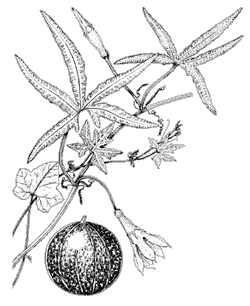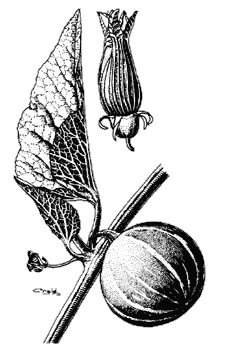Cucurbitaceae (cucumber family)
The cucurbits, as they are called, number 750 species worldwide; most species are vines. The flowers vary from barely noticeable to large and conspicuous. The fruits range from small and dry to large and tasty; the latter include cucumbers, squash, and melons. Gourds are hard-shelled squash that are used after they dry.
Two genera of bees (Peponapis and Xenoglossa) are tightly associated with this plant family. Squash or gourd bees are more effective pollinators of cucurbits than most other bees. They seem to be holding their own under competition from introduced honeybees (which collect the pollen but are inefficient pollinators of these flowers), probably because squash bees are active earlier in the morning.
Cucurbita digitata
English names: coyote gourd, finger-leafed gourd
Spanish names: calabacilla (little squash), chichicayote, meloncillo (little melon), melón de coyote (coyote melon), calabaza amarga (bitter squash)
Description
The large, underground tuberous root produces several to many herbaceous stems as long as several yards (meters) in the summer. The stems typically lie flat on the open ground; occasionally they climb into surrounding vegetation with their tendrils. The palmately-divided leaves with very narrow lobes are widely spaced on the stems. (Cucurbita palmata is similar but has broader lobes; the 2 species intergrade in the western Sonoran Desert.) Vase-shaped, bright yellow flowers about 2 inches (5.1 cm) across open before dawn, and wilt by late morning. After pollination, female flowers develop 3-inch (7.5 cm) spheroid gourds, green with yellowish stripes when young, and maturing to straw-colored.
 |
Range
This species occurs from the lowest and driest desert elevations into desert grasslands, from southeastern California to southern New Mexico and into northwestern Sonora.
Notes
The fruit pulp contains toxic and extremely bitter chemicals that humans use to make soap; clothing laundered in it reportedly repels body lice. Humans eat the nutritious seeds which contain up to 35% protein and 50% fat. Coyotes, porcupines, and some other animals can eat the seeds even when tainted by the pulp. Javelina dig up and eat the bitter tuberous roots, which they can sniff out even when there is no vine above ground. People have used the gourds as containers since prehistoric times.
The modifier “coyote” is in the name of a number of Southwestern plants. Most often it identifies wild relatives of domesticated plants. In the mythology of the O’odham and other native cultures, Coyote (a spirit who often appears in the form of the animal of the same name) is, among his other attributes, a trickster and all-around rascal who makes a great deal of mischief. One of the things he does is ruin useful objects by defecating on them. That’s how the world got coyote gourds, coyote tobacco, and coyote passion flower, among others. The actual animal coyote marks its territory by defecating on conspicuous landmarks.
 |
Cucurbita foetidissima (buffalo gourd) is a related species from higher elevations. It has a similar growth habit, but the leaves are large gray-furry triangles and have a rank odor when bruised. The starches from the very large root are edible after processing, and it is being developed as a potential feed crop. The seeds are a potential commercial source of oil.
Coyote gourd has a cool-season counterpart in Marah gilensis. It sprouts in early spring after winter rains and dies back to the huge root by the onset of the dry foresummer. During its brief season it produces a few very large seeds in each of its small, dry prickly fruits. Little else is known about the ecology of this plant.
Tumamoc globe-berry (Tumamoca macdougalii) provided an opportunity for the U.S. Endangered Species Act to work as it was intended. This diminutive plant, with a fist-sized underground tuber and wispy vines that grow and bear small red fruits during the summer rainy season, was thought to be very rare. When a population was discovered in the path of the Central Arizona Project canal during the environmental impact study, the species was quickly listed as Endangered in 1986. The Endangered Species Act funded surveys and ecological studies on the plant over the next several years. The studies revealed the Tumamoc globe-berry to be both common and widespread; it was rarely encountered simply because it’s difficult to see among the shrubs it climbs in, and few people had previously looked for it. The species was delisted in 1993.